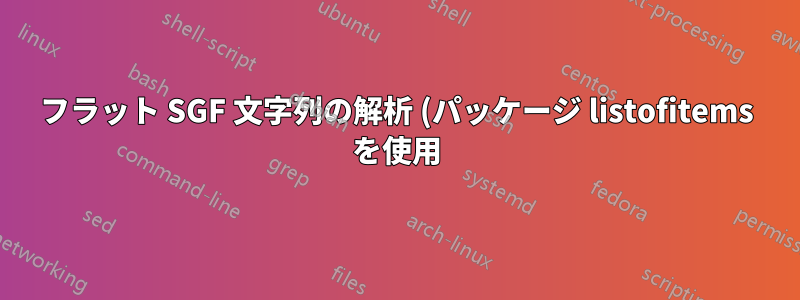.png)
私は解析しようとしていますエスジーエフパッケージの文字列listofitemsSGF はテキスト形式のツリーですが、現在は単純化のため、単一分岐の SGF のみに取り組んでいます。
私がやろうとしていることの例は次のとおりです。
\documentclass{article}
\usepackage{listofitems}
\usepackage{tikz}
\newcommand{\parseSgf}[1]{
% From [this answer by @StevenB.Segletes](https://tex.stackexchange.com/a/429895/64441).
\setsepchar{;}
\defpair{[]}
\readlist\Z{#1}
\begin{itemize}
\foreach \i in {\Z}{
% TODO: if key is either `B` or `W`:
\item Color: {\i}[0] and Coords: {\i}[1]
}
\end{itemize}
}
\begin{document}
\def\sgfA{;B[ab];W[cd]}
\def\sgfB{(;GM[1]FF[4]CA[UTF-8]AP[Sabaki:0.52.2]KM[6.5]SZ[19]DT[2024-02-05];B[as];W[bs];B[cs])}
\parseSgf{\sgfA}
\parseSgf{\sgfB}
\end{document}
sgfAこれは適切な SGF ではなく、単なる単純な例です。次のような順序なしリストを印刷したいと思います。
- 色:
Bおよび座標:ab - 色:
Wおよび座標:cd
\setsepcharしかし、 とを\defpair適切に使い分ける方法や、 でそれらを使用する方法がわかりません\foreach。
sgfBBは適切な SGF 文字列です。また、または以外のキーを無視するという追加の問題もありますW。 でこれを行う方法を知っている人がいればlistofitems、それはプラスになります。
答え1
主に興味があるのは、構文B[xy]またはW[xy](およびxはy単一の文字) を持つ文字列の部分だと理解しています。したがって、以下のコードでは、他のすべてを無視します。
これはおそらく最終バージョンとは考えられませんが、おそらく次のようなもので十分でしょう。ほとんどのことは文字列の分割に関係しているので、この場合は expl シーケンスを使用しました (文字列に適切な構文が含まれていない場合は、「項目がありません」というエラーが表示される可能性があることに注意してください)。
\documentclass{article}
\ExplSyntaxOn
\cs_generate_variant:Nn \tl_set:Nn { Ne } % You might need to add this if the version of your TeX installation is not the most recent one
\cs_generate_variant:Nn \seq_set_split:Nnn { Nne }
\NewDocumentCommand{\parseSgf}{ m }{
\tl_set:Ne \l_tmpa_tl { #1 }
% remove ( and ) from string
\tl_remove_all:Nn \l_tmpa_tl { ( }
\tl_remove_all:Nn \l_tmpa_tl { ) }
% store the contents of #1 in a sequence with ; as delimiter
\seq_set_split:Nne \l_tmpa_seq { ; } { \l_tmpa_tl }
\begin{itemize}
% loop over all items in sequence
\seq_map_inline:Nn \l_tmpa_seq {
% split string at [ and store result in another sequence
\seq_set_split:Nne \l_tmpb_seq { [ } { ##1 }
\bool_if:nT {
% test if first part of sequence is B or W
\str_if_eq_p:ee { \seq_item:Nn \l_tmpb_seq { 1 } } { B } ||
\str_if_eq_p:ee { \seq_item:Nn \l_tmpb_seq { 1 } } { W }
} {
\tl_set:Ne \l_tmpa_tl { \seq_item:Nn \l_tmpb_seq { 1 } }
\tl_set:Ne \l_tmpb_tl { \seq_item:Nn \l_tmpb_seq { 2 } }
% remove ] from string
\tl_remove_all:Nn \l_tmpb_tl { ] }
\item Color: ~ \l_tmpa_tl {} ~ and ~ Coords: ~ \l_tmpb_tl
}
}
\end{itemize}
}
\ExplSyntaxOff
\begin{document}
\def\sgfA{;B[ab];W[cd]}
\def\sgfB{(;GM[1]FF[4]CA[UTF-8]AP[Sabaki:0.52.2]KM[6.5]SZ[19]DT[2024-02-05];B[as];W[bs];B[cs])}
\parseSgf{\sgfA}
\parseSgf{\sgfB}
\end{document}
答え2
ここにlistofitemsアプローチがあります。ただし、 などの SGF 文字列内の不適切な構文はテストされず;B[ab[;W]cd]、テスト ケース と同じように応答します\sgfA。
\documentclass{article}
\usepackage{listofitems,tikz}
\long\def\Firstof#1#2\endFirstof{#1}
\ignoreemptyitems
\newcommand{\parseSgf}[1]{%
\setsepchar{;/[||]}%
\readlist*\Z{#1}%
\begin{itemize}
\foreachitem \i \in \Z[]{%
\itemtomacro\Z[\icnt,1]\tmp
% TODO: if key is either `B` or `W`:
\expandafter\if\expandafter\Firstof\tmp\endFirstof B
\item Color: \tmp and Coords: \Z[\icnt,2]
\else\expandafter\if\expandafter\Firstof\tmp\endFirstof W
\item Color: \tmp and Coords: \Z[\icnt,2]
\fi\fi
}%
\end{itemize}
}
\begin{document}
\def\sgfA{;B[ab];W[cd]}
\def\sgfB{(;GM[1]FF[4]CA[UTF-8]AP[Sabaki:0.52.2]KM[6.5]SZ[19]DT[2024-02-05];B[as];W[bs];B[cs])}
\parseSgf{\sgfA}\bigskip
\parseSgf{\sgfB}
\end{document}




